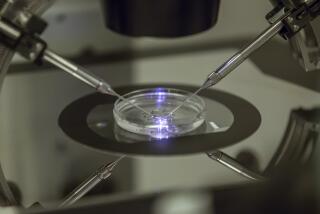There’s Nothing ‘Anti-Life’ About Medical Cloning
- Share via
Political advertising on “therapeutic cloning” already has started, and it appears the U.S. Senate debate on this issue is going to be clouded by emotional appeals rather than sound science.
That’s a shame because therapeutic cloning, which scientists call “somatic cell nuclear transfer,” is vitally important and complex. It should be decided by carefully weighing the facts and the moral choices.
As a cancer survivor and one who is pro-life, I have struggled with the issue and am convinced that Congress should not ban this important research.
Most Americans agree that attempting to produce children by cloning human embryos is wrong. Yet it is essential to keep in mind the critical differences between cloning human beings and somatic cell transfers.
Cell transfers involve removing the nucleus of a donated egg cell and replacing it with the material from the nucleus of a somatic cell--such as a skin cell--from the patient being treated. Then the cell is stimulated to begin dividing.
The resulting collection of dividing cells never leaves the lab. It is never transplanted into a womb, and sperm never fertilizes it.
Once the cells begin dividing, stem cells can be derived about six days later, just as they can be extracted from embryos created through in vitro fertilization. When combined with stem cell research, somatic cell transfers could be used to develop innovative treatments that allow cells to function again and restore hope to millions of families.
The added benefit of somatic cell research is that the stem cells produced would not be rejected when transplanted back into the patient who donated the somatic cells.
In other words, the technology would allow a patient’s own cells to treat or cure that patient’s disease.
Although some believe that stem cell research could proceed without somatic cell transfers, the overwhelming majority of scientists believe somatic cell transfers are essential in turning research into treatments that actually help patients.
The National Institutes of Health recently released a report that makes the link between somatic cell transfers and stem cell research, noting the benefits in countering transplant rejection. The prestigious National Academy of Sciences has concluded that reproductive cloning is unsafe but that somatic cell transfers have “considerable potential” and should be permitted.
Scientists are joined by a wide range of patient advocacy groups that regard this research as a matter of life and death. They agree that reproductive cloning should be illegal but somatic cell research must move forward.
When listening to what some opponents say, I’m reminded that we’ve been down this road before. Recombinant DNA is one of the most important recent advances in medical research.
Yet when the technology was developed in the 1970s, it was bitterly opposed by some of the same people who today oppose somatic cell transfers.
They even used the same images now being invoked--Frankenstein’s monster, the hatcheries of “Brave New World” and eugenics. They proposed banning the research.
Recombinant DNA research is responsible for human insulin for diabetes; Herceptin for patients with breast cancer; Epogen for patients with kidney disease; Enbrel to help patients with rheumatoid arthritis; and Pulmozyme, which has prevented childhood deaths from cystic fibrosis.
A victory by the opponents of controversial research 30 years ago would have been anti-life: It would have meant many more deaths and untold human suffering.
I’ve lived the terrible ordeal of watching a loved one die from a disease without a cure. I don’t want people to go through the same thing a decade from now because we banned this latest research. When the Senate votes on the issue, it should support this life-saving effort.
*
Connie Mack is a former member of the U.S. Senate (R-Fla.).






